— David Hoffman, Fellow, National Institute of Medical Herbalists
On February 29, I boarded a red eye in San Francisco after five joyful days worshiping at the majestic, chakric altar of Mount Shasta. Less than six hours later, I landed in a parallel universe in which grocery stores were being cleared of toilet paper and, eventually, pretty much everything else.
I proceeded to engage in the most rational response I could muster — researching the details of my March trip to Barcelona, Seville, and Granada with my son. Cognitive dissonance is real. Within two weeks’ time, before my disbelieving eyes, the world as I knew it closed down, locked down, and went dark… including my home state of New Jersey, the entire country of Spain, and the airline that was supposed to take us there.
Try a new grounding ritual
In the intervening months, for better and worse, we’ve integrated these shocking realities and we’re preparing for new ones. We’ve learned how resilient we can be in the face of extraordinary discordance. As I’ve surrendered to the loss of many things which I love (like travel), I’m learning to lean into grounding rituals.
Drinking nettles is one of them.
Nettles are a magical food
My sister in travel, crystals, and all things holistic, Pat Robinson, introduced me to nettle tea.
Nettles contain lots of minerals (including iron and calcium), antioxidants, fatty acids, bioflavonoids, carotenoids, and vitamins, including the sometimes difficult-to-get-enough B vitamins. Did you get that? Read the list again.
Nettles are also high in fiber and have more protein than any other plant (comparable to beans and chicken).
On the run? Empty fridge? Drink a big glass of nettle infusion and eat some of the leaves… you might be good to go.
When I’m tired, when I’ve eaten something that isn’t very healthy, when I’m feeling the beginnings of a cold, when I’m itchy, sneezy, or achy, I reach for the nettles. Well, that’s sort of misleading since I drink it nearly every day. When I’m feeling a little off, I just drink more.
PubMed loves nettles, too
You can’t believe the trove of scientific literature on the benefits of urtica dioica (nettles)!
- It is a potent anti-inflammatory.
- It reduces histamine, easing itchy, sneezy seasonal allergies and hay fever.
- It helps with pain relief.
- It has noticeable activity against both Gram-positive and Gram-negative bacteria
- It eases the symptoms of benign prostatic hyperplasia (BPH).
- This fascinating 2016 study from the Journal of Food, Science, and Nutrition reveals the nutritive power of nettles and how its flour stacks up against wheat and barley.
Click here for references.
Medicinal benefits for these conditions
- Anemia (it contains both iron and vitamin C to enhance absorption)
- Diabetes (improved glycemic control)
- Kidney and bladder problems including urinary infections and stones
- Excessive bleeding (internal and external use) including menstrual bleeding
- Hemorrhoids (ingest or learn to make a salve here)
- Fatigue (those B vitamins! It’s energizing so don’t drink close to bedtime)
To summarize its activity
I tip my hat to herbalist and Renaissance woman, Nina Judith Katz:
- The leaves are nutritive, anti-inflammatory, astringent, diuretic, immunotonic, renal tonic, liver tonic, uterine tonic, detoxicant, glandular, antiseptic, hemostatic, and galactagogue. You can probably guess what most of these mean except maybe the last two. A hemostatic helps to prevent and stop bleeding, which is the first stage in wound healing. A galactagogue increases milk supply.
- Topically, it is a rubefacient, which increases blood circulation by dilating capillaries. It’s a hemostatic so it makes a great poultice, which you can apply where you are bleeding or have pain, swelling, itchy rashes, or an infection. It soothes dry skin and makes hair shiny and strong (as a rinse), too.
- The seeds are tonic, adrenal, and anthelmintic (destroys parasitic worms).
- The roots are astringent, anti-inflammatory, glandular.
Stinging nettles support detoxification, too. DId you know that they can be used for removing heavy metals and organic compounds from contaminated soils?
I mean, seriously. Imagine what it can do for our internal terrain!
Buy organic nettles
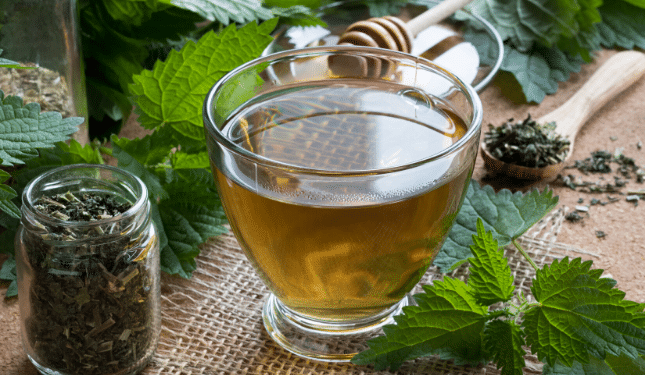
Buy organic dried nettles. Think about its ability to remove toxic contaminants from dirt… you want the plants grown in rich, clean soil. Also, watch for brands that include too many stems. I like Monterey Bay Spice Company. Pat swears by Mountain Rose Herbs. A good option on Amazon is Starwest Botanicals.
If you buy in bulk, double ziploc the sealed bags and store them in a cool, dark, dry place. I store the open leaves in a stainless canister like this.
Making nettles is easy
Bring water to a near boil (3 to 4 mm bubbles). I often prepare my nettles in a dedicated French press because it’s quick and I like the added squeeze of filter extraction. If you also use your press for coffee, consider swapping the mesh filter so there’s no residual odors.
Even easier, pinch some leaves in a mug, steep for a few minutes (I like mine dark), and sip using a bombilla (tea straw).
I like the way nettles taste. A lot. I don’t add sweeteners to my drinks anyway but many do. Once you start drinking the stuff, you’ll find out how you prefer it. I like it strong, so I use 2-3 heaping tablespoons to 8 cups of water, which works out to a good inch or more of dried leaves at the bottom of the press.
Just like bone broth remouillage (stock made from bones already used once), some reuse their nettles once or more, occasionally boosting it with a scoop of new leaves on top. I don’t. I’ll eat a spoonful for the protein and fiber and toss the rest. They don’t taste bad. They aren’t delicious either. If you’re eating the leaves, short blanching (3 to 5 minutes) is the way to go for more nutrition. They can become bitter if you overcook them. If you want to eat more than a spoonful, try adding a bit of garlic ghee or butter!
If you make a large batch, store the excess in the fridge after it cools. It can start to smell funny if you leave it out for more than 12 hours.
Got ahold of fresh leaves?
If you’re using fresh leaves for your infusion, the rule of thumb is about 1 cup of leaves to 2 cups of water. Take care though… don’t touch them or stick your nose in fresh green nettles — OW!! It can feel like a bee sting or a sudden, sharp dose of pepper spray. Nettles don’t sting once boiled or steamed for a few minutes, soaked in cold water overnight, or dried until brittle.
How much and when to drink?
Start slowly. If you’re sensitive, use fewer leaves and/or more water. Maybe start with a 1/2 cup. Prepare to pee more than usual. Its diuretic effect is cleansing to the kidneys and bladder. Just make sure to drink a lot of plain water before and after (yeah, you’ll be sloshing around a bit). It sometimes gives me a headache if I’m not hydrated.
If you’re intermittent fasting, this might be just the boost you need.
I drink 2 to 4 cups a day, trying to remember to finish up by mid to late afternoon as the B vitamins can be stimulating.
When I travel, I always pack a supply of dried leaves and tuck a stainless bombilla straw in my toilet kit. So far, TSA hasn’t hassled me about it 😉
Enjoy! Let me know if you give it a try. Happy Fall.
References
PubMed
Phytalgic®, a food supplement, vs placebo in patients with osteoarthritis of the knee or hip: a randomised double-blind placebo-controlled clinical trial, Arthritis Research and Therapy, 2009 (active ingredient in Phytalgic is, yep, stinging nettles)
Urtica spp.: Ordinary Plants with Extraordinary Properties, Molecules, 2018
Other
The Beauty and the Beast, The Fat of the Land, horticulturist Sarah West, 4/24/14 (I love this one!)
Brewing Nettle Tea and its Health Benefits, The Spruce Eats, 3/1/19
Nettle Tea – How to Make a Natural Spring Tonic, eartheasy, 3/8/10
Stinging Nettle, Mount Sinai Health System, last accessed 9/22/19
Stinging Nettle Weed, the Wild Superfood, Healing from Home Remedies, last accessed 9/26/19
What are the benefits and uses of stinging nettle? Medical News Today, 5/22/19
When in doubt, try nettles! BotanicWise.com, 5/2/16
Photo credit: Adobe stock #176906756

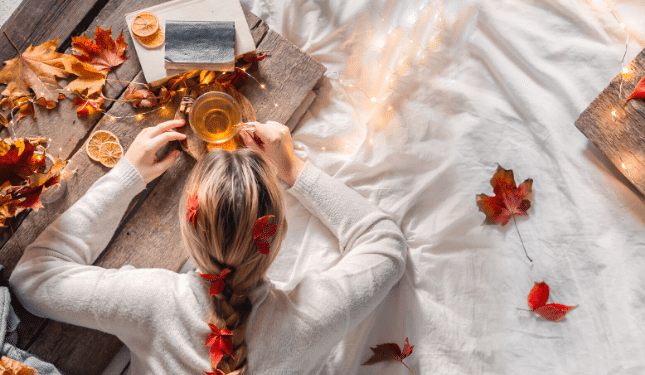


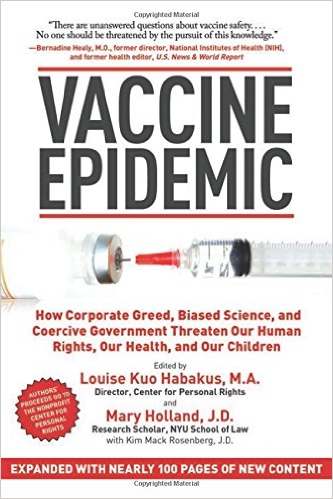


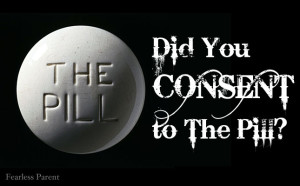



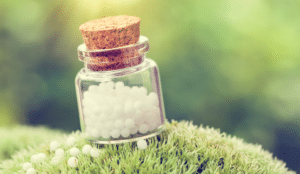

Hi Louise,
I happened upon your website searching for how to do a coffee enema yesterday. Thank you for the great info as always! I think about you from time to time. I’m living in North West Arkansas since February. If you’d like to reconnect feel welcome to email me.